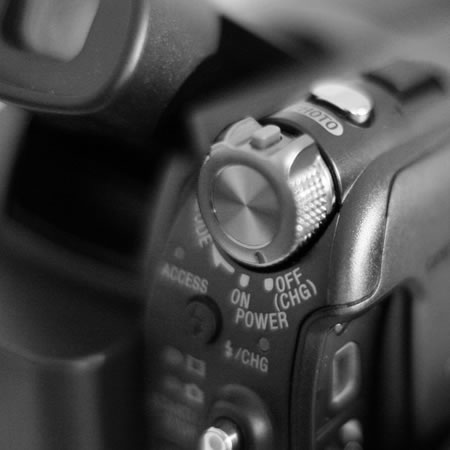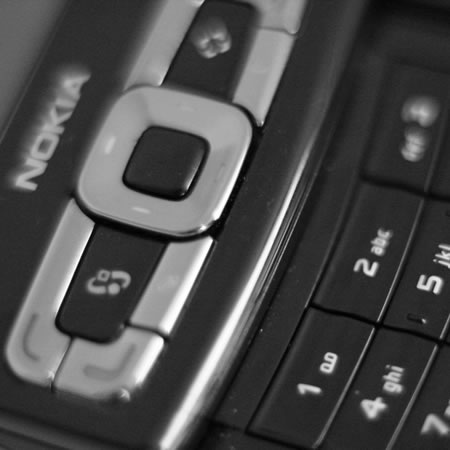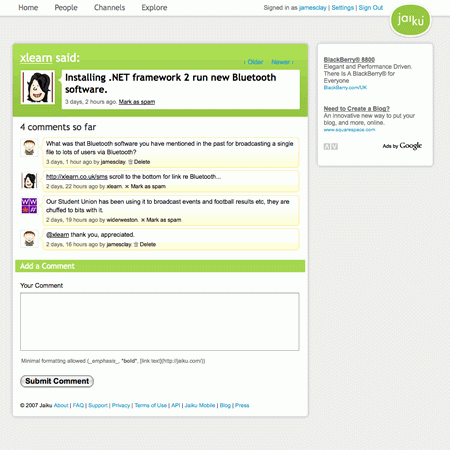This is a list of technologies which I have used extensively over the last twelve months. The reason for the list was partly down to the lists Steve Wheeler has been posting on his blog, and a prompt from him on Twitter. This is not an exact copy of Steve’s format I have also worked on a list of web tools as well. I do quite like this format which gives an opportunity to review and share the tools which have made a difference to the way I work and have enhanced what I do.
Here are my top ten technologies in reverse order.
10. PSP
So it’s not the best selling portable gaming machine of 2008, that goes to the Ninetendo DS, and yes the text entry is awful. However from an e-learning perspective, the most successful device I have demonstrated, used, and also used by learners has to be the PlayStation Portable, the PSP. Unlike the iPod touch, the PSP does not require iTunes and can be connected to a PC via a simple USB cable. With extras you can use Skype, record video and audio, and use GPS. The PSP also has built in speakers which means you don’t always have to use headphones. However it comes with no onboard storage, so you will also need to buy a Memory Stick Duo for it. The wireless browser is okay, but nowhere near the level of usability or sophistication of the iPod touch browser. If you do have a PSP or get a PSP, make sure you get the camera. The camera which as digital cameras go is pretty poor quality at 1.3MP and a poor lens, does capture images and video. The key why it works (and works well with learners) is that reviewing the images and video is easy on the big screen (well for a mobile device) and certainly much easier than small pocket digital cameras.
9. Asus EeePC
It was announced in 2007, but didn’t really start shipping until 2008. I got an early 2GB model and was impressed as were lots of other people. We did go out and buy a bundle of 4GB models with webcams and were impressed even more. Yes the screen is small at 7″, the keyboard is small, the onboard storage is small, the battery life is low. However the smallness is one of the EeePC’s strengths and the price, well you couldn’t grumble about the price. For the price you get a machine which is entirely suitable for surfing the web, e-mail and the odd bit of creating documents, presentations, audio and video recordings. Probably the biggest impact of the Asus EeePC has been on the market and we have seen every major manufacturer jump on the bandwagon and produce their own versions. Some are bigger, most are more expensive, but the market now has a wide choice of small netbooks (as we are calling them) to choose from.
8. iMovie ’08
I didn’t like iMovie ’08 when it first came out in July 2007, so much so that I didn’t go out and buy iLife ’08 for my home Macs. At work when I got my new 24″ iMac it came with iMovie ’08 so I asked for iMovie HD ’06 to also be installed. However due to using some HD cameras (see below) I was “forced” to use iMovie ’08. The more I used iMovie ’08 the more I grew to like it. I like it so much now that it is my movie editor of choice. It does take some getting use to, and the desktop layout is totally different to the ’06 version. Once you get pass that (and on the basis you don’t need special effects) iMovie ’08 is a very sophisticated program which allows me to create quite complex videos, such as this one I created for the JISC Online Conference.
7. Sony HDR-SR8
So you want to shoot HD footage? To be honest there are a plethora of HD video cameras out there at a range of prices. This is at the high end of the consumer market, though you do get a lot of features. Key ones for me are, a decent lens, full 1080i resolution, a 100GB on board hard drive, and I also had a selection of microphones as well. I used it a lot for taking video this year and very pleased with the end results. Easy to import the video into iMovie ’08, edit and export.

This bloopers tape from the JISC Online Conference uses a lot of footage take by the HDR-SR8.
The HDR-SR8 is also quite good at taking still photographs too. The SR8 model is now no longer available, but other Sony HDR Cameras are.
6. Panasonic HDC-SD5
There are two HD cameras on my list, the Panasonic HDC-SD5 is cheaper than the Sony HDR-SR8, it does not have the capability for external microphones and only has an SD slot for capturing video and images. However it is a lot lighter and smaller than the HDR-SR8 and this was it’s main strength, I could drop it in my pocket and then be able to take footage very quickly and easily. As the footage was on an SD card, cards could be swapped over, so as footage was imported and edited, the camera with another card could be used to shoot new footage – a real asset in a college with limited resources. The classic ALT-C videos I did, the Digital Divide Slam and the Dinner video were both recorded using the HDC-SD5 and I was impressed with the quality of the footage and even the audio capture on the Slam video.
Like most HD cameras, it has been replaced by a newer model, the Panasonic HDC-SD9 but you can still buy the SD5 if you want.
5. Edirol R09
So my phone can record audio, as can my PDA; however when it comes to recording audio quickly and easily but at a quality that is good enough to listen to, the Edirol R-09 is for a me a must have device. Recording as either WAV or MP3 direct to an SD card, the audio quality is excellent. Very easy after recording to connect a USB cable and copy the recordings over to edit in Audacity or Garageband. It is very portable and the fact it uses AA batteries means if they run out, they are easy to replace. Main downside is cost, but in this case I do believe it is very much you get what you pay for.
4. 3G USB Stick
I have been using 3G for years, but my Vodafone 3G USB Stick has been fantastic this year. In metropolitan areas I have been getting very fast download speeds, almost as much as the advertised 7.2Mbps! When there is no wifi, or the wifi is patchy, or the wifi costs too much, the 3G has provided access to the internet quickly and easily. It works well across most of the country (well where I have travelled to) and has enabled me to stay in touch via the web and e-mail.
3. JoikuSpot
A simple idea which just works. Basically it turns my Nokia N95 into a wireless hotspot, allowing me to connect multiple wireless devices to my phone’s 3G internet connection. I start JoikuSpot and once started I can then join the wireless and surf the internet. Usually I am using my iPod touch or my MacBook Pro. The Light version only really does internet, it doesn’t allow e-mail or https for example, whereas the Premium version does; this is the reason I upgraded to the Premium version and very pleased I am with it. The main downside is the impact it has on the battery life on the Nokia N95, down to less than four hours, often less!
2. iPod touch
So it’s not an iPhone, but the iPod touch can pretty well do a lot of what the iPhone can do. It is cheaper and there is no monthly charge. Yes there is not SMS, no phone capability, no GPS, no camera and no 3G; however pretty much it can do everything else an iPhone can do. Of all the mobile devices I have used (and as you might expect I have used a lot) the iPod touch has provided for me, through its wifi connection, the best mobile browsing experience. Whereas on the Nokia N95 I will use the browser to find traffic or train information, on the iPod touch I will use the browser to browse the web and browse for some time. It makes browsing on a mobile device not only a usable experience but a pleasurable experience. The screen on the iPod touch is really nice and as a result video looks great. The touch interface is the best I have ever used, very intuitive and easy to pick up, oh and it works. You will need to consider that the touch interface does mean the screen gets grubby pretty quickly and the included cloth will need to be used on a regular basis. Another key advantage for me is the wealth of applications available and there are some really good ones out there. I have found that I am using the ones which interact with Web 2.0 services the most such as Evernote, Twitterfon and Facebook. One feature which works really for me is the ActivSync integration with Exchange, this means for work e-mail and calendars I can access them anywhere with a wifi connection. As it is a live connection, there is no need to sync and that is what sets the device apart from Windows PDAs I have used in the past. I do find typing on the iPod touch very simple and much nicer than using a phone keypad, but I know for some it’s not their cup of tea. Overall I really like the iPod touch, it exceeded my expectations, I use it on a daily basis and I can’t even really imagine what the next generation version will be like.
1. Nokia N95
My number one device for 2008 is the Nokia N95 8GB
mobile phone. For me the Nokia N95 is much more than a phone, it is a device which allows me to create upload and connect. Like the iPod touch I use it on a daily basis, though to be honest rarely as a phone or for SMS. The 5MP camera has an excellent lens and can be used to take some nice photographs. I use Shozu to automatically upload my photographs to Flickr or Facebook over the phone’s 3G connection or if in the right place over wifi. The phone also takes some nice video as well and I can use Shozu to upload that as well automatically. The Nokia N95 does come with a web browser, which is usable, but nowhere near as nice as Safari on the iPod touch. However all is not lost, using JokiuSpot (see above) I can turn the N95 into a wifi hotspot and use the N95’s 3G connection and the iPod touch for browsing, job done. Video works well on the N95 and simple MP4 files work well, though the screen is small, the phone comes with a composite video cable which allows you to show what is on the phone on a video screen or through a projector. The onboard speaker is okay, though the one on the Nokia smaller N73 seems louder! The s60 operating system does allow you to install third party applications and I do like the Jaiku application over the mobile Jaiku interface and there is also an s60 Twitter application too. Qik on the N95 turns it into a broadcast device, Qik is a service which allows you to stream live video from your phone to the internet and it can be very effective. I also use the phone to read QR codes which it does quite well. The N95 also has built in GPS and though routing software is extra, for checking where you are using Nokia Maps the phone works great. I also like how Shozu geo-tags the photographs I upload to Flickr too. It’s not all perfect, the device is very chunky and very thick, if you like thin phones, then you won’t like the N95. I am not a great fan of the keypad, but it’s better than some I have used, and to be honest I don’t like phone keypads anyhow!
Overall though, on the basis of how I use the N95, how often I use the N95 and how annoyed I get when it runs out of battery, the Nokia N95 is my number one technology of 2008.

What is yours?



